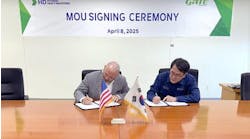People have long been fascinated with predicting the future. Specifically, what life will be like in "the future." Many early predictions, such as the idea we would populate the moon and fly around on jet packs by the year 2000, proved to be way off base, while others, such as early designs of the helicopter, elevated freeways, and talking Coke machines were very close to reality.
Recently, a handpicked group of industry experts gathered to discuss what the future of offshore facilities might look like. Their conclusions were at once both predictable and completely unexpected.
Looking back to look forward, the group examined a collection of artist's drawings from the 1950s predicting the various surface-piercing facilities that would be needed to drill and produce in deepwater. With little variation, each of the current solutions in place (semisubmersibles, FPSOs, Spars, TLPs, and compliant towers) were represented.
In reviewing Offshore's "Deepwater Production Solutions" poster, which contains a list of all current designs, the group learned there are over 90 concepts currently available. However, all of those also fell into the previously stated solution categories.
So why are there so many similar solutions on the market, and does the industry really need a new one?
One reason for the many different designs of similar structures, such as semis, is that each design is proprietary. Smaller companies looking to break into this market can often suceed if they can develop a design that is not only distinct enough to call their own, but also improves in some way on what is already out there. This evolutionary process has produced a range of Spar designs, each suited to a different environment and production scheme.
While the free market encourages a variety of concepts, and the operators decide which are put into place, the industry group was not sure so many designs is the best way to serve operators' needs. For one thing, some of the designs are further along in their testing and evaluation than others. It's easy for a company to bid on a project and propose a novel solution, but if it is untested or does not have a track record in the field, it has little chance of being chosen.
The problem, as is so often the case, comes down to funding. It is expensive to conduct model testing on a new design. Typically, a smaller company lacks the resources to take a design from concept to field trial without at least a guarantee from the operator. The operator, as stated, is hesitant to select or fund a new design that has not been tested.
So if such gridlock exists, where did the designs we have come from? How did the industry move beyond fixed-bottom jackets to semis and FPSOs, compliant towers, and mini TLPs? The answer is as simple as it is cliché: Necessity. Conventional technology could not take the operators into the environments and water depths to produce resources they knew were there. In such cases, the risk was worth the reward. As drilling and production moved into deeper water and harsher environments, new designs were required.
Now there are various, field-proven solutions that can take production out to as far as 6,000-ft water depth, but drilling has moved well beyond this. In addition, there are only a few, high-end solutions for these depths. As everyone knows, the market makes no distinction between oil brought up from the dessert and oil recovered from below 10,000 ft of water. The price paid is the same.
That means in addition to the ability to produce in these depths, the industry will require the ability to produce economically. Is this a facility issue? Will it require some new revolutionary design not yet conceived? That is a possibility, but what's more likely is that current designs will be further refined to meet these needs.
There are a number of related technologies now under development that could substantially reduce the topside loads on deepwater production facilities. Subsea separation, monobore completions, polyester mooring, and smart completions all reduce the weight a floating facility must carry, at the same time reducing the size and cost of this facility. Automation will surly continue to increase, reducing the number of people required on a platform, which reduces crew quarters, an additional savings of weight and size.
Beyond these evolutionary changes is the option of no surface facility at all. Subsea tiebacks are increasing at a rapid rate, driving a variety of research. It may be possible in the future that no surface facility is required. Production could be separated at the seabed, clean water and sand removed, and the oil and gas sent to shore.
It is interesting to consider that a group of engineers, who design topsides for a living, would come up with such a solution, but it is this sort of thinking that has driven our industry from the very beginning.


